Filters for Aquatic Caudates
by Jennifer Macke
Filters are one of the areas where pet shop employees, even those that know a lot about fish, may have difficulty giving advice. Caudate tank setups are not exactly the same as fish setups, and the filtration method needs to be correct for the needs of the animal. In particular, larvae tanks and shallow setups create special filtration problems.
Three types of filtration
There are three basic forms of "filtration" that a filter may provide. Different filters provide these kinds of filtration to varying degrees.
- Mechanical Filtration - the trapping of debris. This is the most obvious purpose of most aquarium filters.
- Chemical Filtration - the chemical destruction of toxic substances. This is the role of activated filter charcoal, which absorbs metals and some organic toxins.
- Biological Filtration - the breakdown of toxic waste products (ammonia) into non-toxic form (nitrate). This process is performed by bacteria, and these bacteria are assisted to varying extents by different kinds of filters. This is probably the most important, but most often overlooked, kind of filtration. No amount of mechanical filtration can substitute for a healthy biofilter. For more information, see Water Quality and Cycling an Aquarium.
Filtration requirements for aquatic caudates
A filter for a caudate may provide:
- Waste removal (i.e. mechanical filtration).
- A current (for species that live in currents naturally) or no significant current (for most caudates).
- No escape routes! Avoid filters that require a large opening around the tank lid.
- No significant transfer of heat into the water. All electrically-driven filters create some heat transfer into the water. If you have difficulty keeping your tank cool enough in summer, this may be one issue to consider.
- Biological filtration. This can be provided by gravel, rocks, and other porous substrates, but the filter may assist.
- Good oxygenation.
Pros and Cons of specific filter types

Sponge filter, driven by either an airstone or powerhead.
- Pros:
- Inexpensive.
- Does not produce heat (unless powerhead is used).
- Does not trap larvae or small live food.
- Keeps water well-oxygenated.
- Cons:
- Mechanical filtration only, and not very efficient.
- Comments: This is the ideal form of filter for raising small larvae.
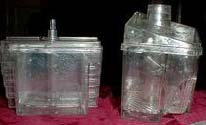
Corner filter (a.k.a. "box filter"), driven by an air pump. Comes in many varieties, including the "Small World" and others that require replacable cartridges.
- Pros:
- Inexpensive.
- Does not produce any heat.
- Keeps water well-oxygenated.
- Does not produce a strong current.
- Cons:
- Requires a noisy air pump.
- Mechanical filtration is less effective than for motor-driven pumps.
- Unattractive, needs to be hidden behind tank decorations.
- Comments: This is an inexpensive and effective filter for most tanks.
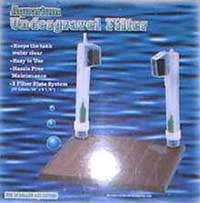
Undergravel filter, driven by a powerhead or airstone.
- Pros:
- Inexpensive.
- Provides excellent biological filtration.
- Does not produce a current or heat (particularly if an airstone is used).
- Keeps water well-oxygenated.
- Cons:
- For use in tanks that are not filled to the top, the uptake tubes must be cut off to the right height.
- Cleaning out debris under the filter plate is difficult.
- The gravel size required is inappropriate for animals that may swallow gravel (axolotls, for example).
- Comments: Because removing debris requires dismantling the aquarium, this filter takes more work in the long run.
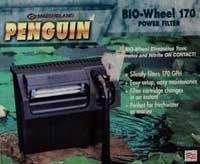
Power filter (a.k.a. "waterfall" or "HOB" [hang on back] filter).
- Pros:
- For completely aquatic amphibians (such as axolotls), this kind of filter provides excellent filtration, but the outflow must be dispersed to prevent a current.
- Easy to clean.
- Quiet.
- Cons:
- It is nearly impossible to prevent the escape of newts from a tank with this kind of filter because of gaps around the filter.
- Must be used with a full (or nearly-full) tank of water.
- Comments: Because of their climbing ability, this filter is usually not a good option for newts. It could be used for axolotls and large larval salamanders, but only if the falling water is dispersed to prevent a current.

Submersible filter.
- Pros
- Effective mechanical, chemical, and biological filtration.
- Can be used to provide a current for those newt species adapted to flowing water.
- Works well even in shallow water.
- Can be used to drive a small fountain or waterfall.
- Quiet.
- Cons:
- May produce enough heat to raise the temperature in the tank, particularly in small tanks.
- Creates a current, which must be dispersed for those species that do not appreciate a current.
- Provides less aeration than other filters unless a spray bar or fountain is used.
- Comments: Many people love these filters, particularly the Duettos, Eheims, and Fluvals. However, I have had very poor results with the Sand Shark submersible. The Sand Shark did not filter effectively, and it always increased the water temperature by several degrees.
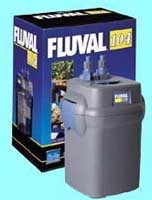
Canister filter.
- Pros:
- Provides excellent mechanical, chemical, and biological filtration.
- Quiet.
- Cons:
- Expensive.
- Requires two fat tubes going into the tank (difficult if you have a screen top).
- Requires space under the tank.
- Comments: Aside from cost, this is usually the optimal filtration available for large tanks.
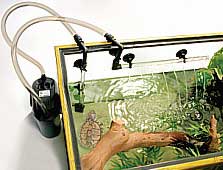
Mini canister filter.
- Pros:
- Provides mechanical, chemical, and biological filtration.
- Quiet.
- Cons:
- Appropriate for small to medium sized tanks only. (The tubing provided with the ZooMed 501 is only long enough to reach into a tank up to 12 inches tall.)
- Requires two fat tubes going into the tank (difficult if you have a screen top).
- Requires tabletop space immediately behind (or beside) the tank.
- Comments: Excellent filtration for small tanks.
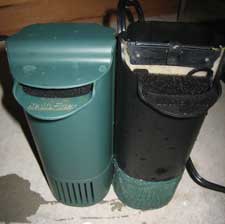
Internal waterfall filter.
- Pros:
- Provides excellent aeration and mechanical, chemical, and biological filtration.
- Very easy to clean.
- Can be used in shallow water.
- Motors have lower wattage (less heat production) than most submersibles.
- Inexpensive.
- Cons:
- Strong water flow; creates a strong current.
- Water intake slots could catch newt tails.
- "Decorative" (rock-like) styles may provide spaces that entrap small newts.
- Comments: Excellent filtration at a bargain price, but watch out for the current.

Airstone only, driven by an air pump.
- Pros:
- Inexpensive.
- Does not produce heat.
- Does not trap larvae or small live food.
- Can be used in any depth of water.
- Cons:
- No mechanical filtration; debris must be removed manually.
- Requires a noisy air pump.
- Comments: Although this may not seem like filtration at all, it does provide good aeration. Together with frequent removal of debris, and an established bacterial colonization in the tank (enhanced by porous surfaces) this can be adequate, particularly for a tank with few animals and no gravel.
No filter
- Pros:
- No cost.
- No heat.
- No noise.
- No current.
- Does not trap larvae or small live food.
- No tubes or cords to be fitted through the lid.
- Cons:
- Accumulation of dirt on the bottom of the aquarium.
- An open or screened lid is required.
- In deep water, poor water exchange between top and bottom.
- Works only with lots of live plants, and a low number of animals.
- Not suitable for stream-dwelling species that naturally live in a current or without plants.
- Comments: Going without any filter or airstone is a viable option for pond-dwelling species. There are several special requirements. In particular, the lid must allow free air flow, and live plants are a necessity.
Recommendations
The choice of filter depends on the species being kept and the convenience of the keeper. Any filter is only as good as the maintenance it gets, so regular cleaning is essential. When experienced caudate keepers were polled, they mentioned using the following specific filters:
- Box filter
- Tetra internal waterfall (Repto-filter or 10i)
- Duetto, Eheim, or Fluval submersibles
- Eheim, Fluval, or Rena canisters
- ZooMed 501 mini canister
- Sponge filter (especially for larvae)
- Undergravel
© Jennifer Macke, June 2009. Revised August 2021 with contributions from Jean-Michele Collet.
